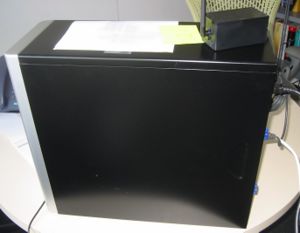Inside the OLPC School Server
Hardware
- Case
- Power
- Main board
- Processor
- Memory
- Firmware
- Expansion slots
- I/O
- USB
- CD/DVD
- Video
- Storage
- Internet Connectivity
Software
- Linux
- Server apps
- Development
Content
- Wikipedia
Administration
- Updates
- Updating XOs
- Student and Teacher accounts
- Data exchange on non-Internet-connected servers
Troubleshooting and Repair
Troubleshooting School Servers
Other pages
Hardware specification
School Server Hardware
While the laptop is rightfully at the center of OLPC, a valuable peripheral is the school server. OLPC will be building and distributing school servers along with the laptops, to extend the storage and computation provided by each laptop, as well as providing a local library and a mesh portal to the Internet.
Unlike the laptop, the school server is more of a collection of services than a hardware platform. In a manner identical to the laptop, OLPC will collaborate with manufacturing partners to provide a cost-efficient hardware platform for running the recommended software. Unlike the laptop, the manufacturing collaboration will not be exclusive. Individual countries will be free (even encouraged) to design and manufacture their own school servers running derivatives of the OLPC school server software.
XS
This will be the school server designed by OLPC. It is mostly designed, but currently on hold as we reconsider manufacturers, and should reach early production volumes in spring 2008. See the specification.
XSX
This is a prototype school server, built for early school trials in country. It will be integrated from off-the-shelf components, and will be overpowered compared to a production school server in order to simplify early demands for system software. See the specification and the implementation.
School server
When we deploy one laptop per child, we must also provide additional infrastructure extending the capabilities of the laptops. While the laptops are largely self-sufficient, a mesh portal providing connectivity and shared resources greatly extends their utility.
These persistent services required by OLPC laptops could conceivably be implemented in a fully distributed manner. They are , however, currently provided more economically by a centralized local resource, the school server. The functions provided by this server are open to debate, but at a minimum they include internet communication and storage resources to the school's wireless mesh.
Currently, the School server is described by these documents:
- The Server Specification introduces the School Server and its functions
- Server Services described the services supported by the School Server
- Server Discussion describes services and enhancements possibly supported by the School Server
- XS Server Software describes the software system being built for release, and has instructions for downloading and installing the software
- The XS Server Specification describes the School Server hardware platform in much more detail.
- Trial1 Server Software describes the proposed first revision of the server software
- Short Term Server Questions is a discussion of issues surrounding the immediate deployment of school servers
- School Service Names
- School Identity Manager
- XS Installing Software has instructions for installing the latest School Server images
- XS_Building_Software
- XS_Software_Repositories
- XS_LiveCD
- XS_Server_Software
- XS_Installing_Software
- XS_Server_P2P_Cache
See also
- IRC - #schoolserver on irc.oftc.net
- Troubleshooting School Servers
- How to debug in a crowded environment
- School server/School district networks
- Bitfrost Security and Identity model
- Thin client
- Server development mailing list
